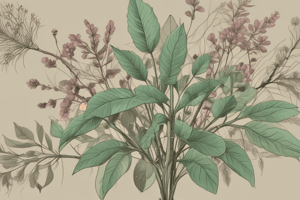Podcast
Questions and Answers
What role do root hairs play in a plant's absorption process?
What role do root hairs play in a plant's absorption process?
Root hairs increase the surface area for absorption of water and minerals from the soil.
How do woody stems differ from herbaceous stems?
How do woody stems differ from herbaceous stems?
Woody stems are thicker and stronger, providing long-term support, while herbaceous stems are softer and more flexible.
Explain the significance of chlorophyll in leaves.
Explain the significance of chlorophyll in leaves.
Chlorophyll is crucial for photosynthesis as it absorbs light energy needed to convert carbon dioxide and water into glucose.
What are two main types of plant reproduction, and how do they differ?
What are two main types of plant reproduction, and how do they differ?
Define indeterminate growth in plants.
Define indeterminate growth in plants.
What are the roles of auxins, gibberellins, and cytokinins in plant growth?
What are the roles of auxins, gibberellins, and cytokinins in plant growth?
How are non-vascular plants different from vascular plants?
How are non-vascular plants different from vascular plants?
Why are angiosperms considered the most diverse group of plants?
Why are angiosperms considered the most diverse group of plants?
Flashcards
Plant Structure
Plant Structure
Plants have roots, stems, and leaves, all with specific functions related to survival and growth.
Root Function
Root Function
Roots anchor the plant, absorb water and nutrients from the soil.
Stem Function
Stem Function
Stems support the plant and transport water and nutrients.
Leaf Function
Leaf Function
Signup and view all the flashcards
Photosynthesis
Photosynthesis
Signup and view all the flashcards
Plant Reproduction (Sexual)
Plant Reproduction (Sexual)
Signup and view all the flashcards
Plant Reproduction (Asexual)
Plant Reproduction (Asexual)
Signup and view all the flashcards
Plant Growth
Plant Growth
Signup and view all the flashcards
Plant Hormones
Plant Hormones
Signup and view all the flashcards
Plant Classification
Plant Classification
Signup and view all the flashcards
Vascular Plants
Vascular Plants
Signup and view all the flashcards
Gymnosperms
Gymnosperms
Signup and view all the flashcards
Angiosperms
Angiosperms
Signup and view all the flashcards
Study Notes
Plant Structure and Function
- Plants are multicellular eukaryotes, characterized by their ability to perform photosynthesis.
- Plants are essential for life on Earth, producing oxygen and serving as a primary food source for many animals.
- The basic plant body consists of roots, stems, and leaves.
Roots
- Roots anchor the plant in the soil and absorb water and minerals from the soil.
- Roots have a variety of structures, including root hairs, which greatly increase the surface area for absorption.
- Different types of roots perform various functions, such as storage (e.g., carrots, potatoes) or support (e.g., prop roots).
Stems
- Stems support the plant body and transport water and nutrients between the roots and leaves.
- Stems exhibit varying structures, including woody stems and herbaceous stems.
- Woody stems are stronger and thicker, providing long-term support, while herbaceous stems are softer and more flexible.
Leaves
- Leaves are primarily responsible for photosynthesis, the process of converting light energy into chemical energy.
- Leaves contain chlorophyll, a pigment that absorbs light energy, and stomata, tiny pores that regulate gas exchange.
- The shape and size of leaves vary depending on the plant species and the environment.
Plant Reproduction
- Plants reproduce both sexually and asexually.
- Sexual reproduction involves the fusion of gametes, typically forming seeds.
- Asexual reproduction involves the production of new plants from existing parts of the plant, such as stems or leaves, and can be significantly faster than sexual reproduction.
Plant Growth and Development
- Plants exhibit indeterminate growth, meaning they can continue to grow throughout their lifespan.
- Growth is regulated by hormones, including auxins, gibberellins, and cytokinins.
- These hormones affect various aspects of plant growth and development, such as cell division, elongation, and differentiation.
Plant Classification
- Plants are categorized into different groups based on their characteristics, including vascularity (presence or absence of vascular tissues like xylem and phloem) and seed production.
- Major plant groups include non-vascular plants (e.g., mosses), vascular plants without seeds (e.g., ferns), and seed plants (e.g., gymnosperms and angiosperms).
- Seed plants can be further classified as gymnosperms (e.g., conifers) and angiosperms (flowering plants). Angiosperms are the largest and most diverse group of plants.
Plant Adaptations
- Plants have evolved various adaptations to survive in different environments.
- Adaptations may include specialized leaves and stems for water conservation or nutrient uptake.
- Plants often have specific adaptations for particular environments, like desert plants with reduced leaves, or aquatic plants with modifications for buoyancy.
Plant Interactions
- Plants interact with other organisms in their environment, including other plants, animals, and microorganisms.
- Symbiotic relationships, such as mycorrhizae (fungal association for nutrient uptake), are common among plants.
- Competition for resources, like sunlight and water, also significantly shapes plant communities and populations.
Studying That Suits You
Use AI to generate personalized quizzes and flashcards to suit your learning preferences.


